


The following are some of the anti-sway bar options I found while researching this:
Their tube bars are a little more reasonable at $470, but still not what
I would call economical. This bar consists of the adjustable end links plus
a torsion tube. The tube can be sized from .125" to .250" wall thickness.
Tri-Point sells solid rear bars that should be matched to the fronts. These
are $120 or so. The rears have two holes for adjustment of arm length,
but are not what people would typically think of as adjustable.
_______________
Date: Thu, 16 Dec 1999 19:51:31 -0500
From: "kevin kelleher" (kellehkj@earthlink.net)
More checking...The RB ( also Pettit bar) front bar is 1-5/16 inch dia and .188 inch wall....huge. With something this stiff, you defeat the independence of a very nice front suspension. They say they know of only 2 arm failures.....
Both M2 (3 adj holes, alum arms) and TP (5 holes, alum arms) are 1-1/4 inch dia, and have 3 or 4 tube thickness options (Brian thinks his M2 is 1-1/4 inch). For the popular .188 inch wall option, the big RB tube is 18% stiffer than these two.
TP has thinner wall versions. The .125" is 77% as stiff a tube as the .188", and the .095" is 63% as stiff. A thick .25" is also available, 14% stiffer than the .188" tube. I think M2 has similar, if not identical options. The M2, at $385 complete, appears to be a good buy.
________________
For the 3rd gen bars, stiffness will be based mostly on (Do^4 - Di^4). Based on this factor, I rated the front bars, relative to stock. (Cirian's site has some misinfo on bar stiffness.)
Size Wall (% stiff incr) Vendors ============================================================== 1.25 solid 114 ST 1.31 .188 92 RB 1.25 .250 86 M2, TP 1.25 .188 62 M2, TP, EB, PF? 1.13 solid 40 AD, Pettit 1.25 .125 26 M2,TP 1.25 .095 4 TP 1.13 .150 0 Stock (w/ poly bush's for comparison)
Rear stock bar is hollow, and larger (17.3mm) in 93 only, all models. Only 19mm upgrade is available (forget the .88" solid Addco bar). Vs the big stock 93, the solid 19mm will be about 50-60% stiffer at stock arm length. I tested the EIB hollow rear at 30% stiffer at 'long' hole, and 50% stiffer at 'short' hole. RB sells a separate 19mm hollow rear bar, looks to be non adjustable.
Notes: (confirm current prices)
TP=Tri-point, adj-5 holes, @mazda-comp?, heim links, $470 fr
ST=Suspension Techniques, @mazdatrix, $272 set, adj solid rear
RB=Racing Beat, $377 fr (Brad Barber noted 2 failures)
M2=Mostly Mazda, adj-3 holes, heim links, $385 fr
PF=Peter Farrel, $350 set, adj solid-? rear
AD=Addco, $175 fr
EB=Eibach, $277 set, adj hollow rear
____________
From: Mark Valskis
Date:April 11, 2000
I just wanted to state for the record that the values I provided for the Racing Beat bars is indeed correct. These values were obtained by actually measuring the dimensions of the bars (both front and rear, stock and RB) and calculating their stiffnesses. Kevin's dimensional data for these bars (which was gathered over the phone, I assume) is incorrect. For instance, the front bar is actually 1.375" in diameter with a .188" wall thickness. I mean no disrespect to Kevin, I just wanted to set the record straight.
__________________
From: rzehr@pacbell.net
Date: 04/05/2002 12:18 PM
The definitive guide to the cheap FD rear swaybar bushing upgrade...
The front swaybar of the FD can improved inexpensively, with the addition of firmer bushings and better end-links. The rear swaybar, however offers fewer options. There are no separate end-links to replace, and the stock u-brackets and bushings are a just-barely fit in the space - no room for wider bushings. One can, however, firm up the stock bushings considerably, to balance improvements in the front.
What this mod does is remove most of the deadzone across the center of the rear swaybar. It might take as much as an inch of slop out at the bar-end. This adds just a bit of oversteer, to help compensate for the understeer from front bar upgrades. Most importantly, it makes the action of the rear bar more linear across the transition and more predictable. The difference is noticable (for about a day) in the direction of more predictable handling. I haven't noticed any added noise.
Start by procuring a two or three (see below) stock rear swaybar bushings for your car (may vary by year) The rubber bushings are available as a separate partno at under US$20 for two. When you get them, measure, because I am quoting measurements from months-old memory, and my memory leaks.
Examine the rubber bushing - note that there is 1/2" of very compressible rubber between the bar and the flat (car-body) side of the bushing. The goal is to replace most of that rubber with something less compressible.
The local plastics shop sold me a 1" strip (Measure!) of 3/8" black plastic a few inches long. Cost less than a buck. I then cut a couple of 1"x1" pieces, and filed a broad squared notch in two sides to match the flat side profile of the rubber bushing. Cut or grind out 7/8"-wide and 1/16" deep on two opposite sides, to allow for the u-bracket that the bushing fits into - it is sort of a really wide Capital-I shape when you are done - a rectangle with four 1/16" serifs.
Take a very sharp knife with a long blade (carving knife), and lubricate it with liquid dish detergent, then use it to cut exactly 3/8" from the flat side of the rubber bushings. This works best if you lay the bushing on its end, with the flat side against a 90-degree surface to help hold the bushing straight. (If you are not confident that you can do this in one long clean slice, buy a spare bushing to practice on.) This should leave 1/8" of rubber between flat side and bar, just as it is around the u-bracket.
Lubricate the rubber, and install the modified bushings with the plastic piece between the rubber bushing and the car body. This involves two bolts at each u-bracket, and should take about 5 minutes. The bolts may require some penetrating lube.

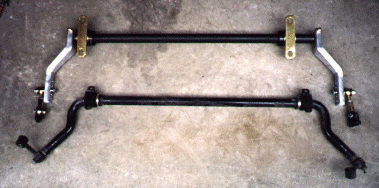
My new Penskes and anti-sway bars should be here shortly from Tri-Point. Just thought I would update people on their anti-sway bars. The new front bar is pictured here with the old one.
I was going to order the .250" wall tubular bar for the front of my car, but Craig said the tubular rear bar to match that was so hard to make that he wasn't going to do any more (unless I want to pay $1000 - 1500 for a one-off). They will still sell the .250" front bar, but no one makes a rear bar (even the solid ones) that will match this. He said that the only application for the .250" front one would be for road race cars where you might want some push to it (with the bigger front bar and a smaller rear).
In addition to the .250" front one, you can get the .188" wall tubular bar (and probably other smaller sizes). Tri-Point recommends and sells the Racing Beat solid rear bar to match this one. So that is the combo I ended up ordering. (Shown below with the old one I took off the car.)
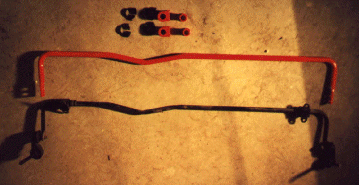
If anyone else is interested in getting the bigger tubular bars (front and rear) instead of the smaller tubular front one and solid rear, email me privately. If we come up with enough people, we may be able to get them to run off a batch of the rear tubular bars. Not sure what the exact price each would be for a batch of these, but they originally quoted me about $500 when they thought they were going to make more of these.
I bought the RB anti-sway bar brace from RB for $78 a while ago. Tri-Point will also sell this.
On a different subject, Tri-Point should have their catalog out very soon.
Pricing (for what I ended up ordering):
Front tubular bar: $445 Bearings for front bar: $175 RB rear bar: $125
Tri-Point: 818-348-5385
__________________
And an update (Jan 4, 1999):
I have Complete Custom Wheel (CCW) 17x10" wheels on the front. I had a small problem with my CCWs rubbing when the steering was at full lock (only when parking). It turns out that this was caused by the wheel rim rubbing on Tri-Point's tubular bars: They hit the ends of the aluminum lever bars (barely).
I don't see this as an issue, but just wanted to let people know if they are contemplating this combination. However, it could be an issue if this knocks the weights off of the wheels if you have the clip on kind of weights and they are mounted inboard.
This may be peculiar to the CCWs, since they also are known to have clearance problems with big brake kits, that are not experienced with other wheel mfrs. But then on the other hand, it is the rim lip that hits the end of the bar, and this should be in the same place on all 17x10 wheels.

Date: Wed, 15 Dec 1999 18:43:00 -0600
From: brad barber (bradrx7@swbell.net)
> Racing Beat also has a modular bar, stunning in annodized appearance. It is > not adjustable, and, properly intalled, does not have the support > destruction potential of a TP bar at extreme (softest) adjustment angles. It > is also sold by Pettit and Mazdatrix.
I must once again caution against using the Racing Beat bar on the track. I suffered a broken arm while accelerating through a left hand corner at 90 mph! I have also seen one other bar broken at the splines in this same location. Both bars were torqued to RB specs.
If safety is important to you:
DO NOT USE THE RACING BEAT BAR on track.
Spend the extra $150 and get the Tri-Point bar. It works better, too. ________________
Date: Mon, 10 Nov 1997 12:15:43 -0800 Just for general information, I removed my Racing Beat front swaybar,
(which will soon it will be on its way to someone else) and replaced
it with my R1/R2 front bar, and thought someone might benefit from a
head-to-head comparison of the two.
There is no comparison.
The Racing Beat front bar, for those who have seen pictures or a live
specimen, is a huge (and I mean HUGE) red bar with annodized blue
forks attached using a spline system. The R1/R2 front bar is a fairly
beefy piece of black metal, with crimped ends.
pictures:
Both bars After replacing the old bar yesterday, the difference was immediately
noticeable. Whereas the car used to corner like "a rock on the end of
a piece of string", the car still corners well, but there is noticeable
roll (not much, but compared to the RB bar, it's very noticeable) in the
front end. I retained my RB rear bar, and it makes a world of difference
when compared to the PEP/Touring/R1/R2 rear bars, so the difference
between the front and rear of the car during "spirited" cornering was
also obvious.
Eventually I became "used" to the setup, as I drove home last night,
and by the time I got home, it was second nature and the car felt
"right" again, but the brief comparison immediately following the swap
was interesting, and I'm sure that a side-by-side comparison of an FD
equipped with the RB bars would show that the system is superior to
the components that came from the factory.
I would highly recommend both front and rear bars, but especially the
front for those of you involved with road course and track events. The
rear bar should be an immediate upgrade for those with PEP and Touring
suspensions, as the rear gets alarming light in high horsepower/high
speed cornering situations, and the swaybar made a world of difference.
pictures:
Custom swaybar/radiator mounts
Installed bar: The front RB bar, by the way, goes for $377 new from Mazdatrix. The rear
bar is considerably less expensive (about $120 or so?).
__________________
An update from Jim...
Date: Sat, 4 Dec 1999 10:38:15 -0800 I upgraded front and rear to the Racing Beat adjustable sway bars
from Mazdatrix. I think I paid $377 for the front, and about $120 for
the rear. The front one is the one that made an appearance in the
infamous David Irvine's web site, along with Trev's FTL billet sway
bar mounts. :)
Prior to their installation, the car would want to "walk" (for lack
of a better term) in corners at high speed. The rear would become
semi-loose and it wasn't a confidence builder, especially when we
were screwing around on twisting backwoods roads (freshly paved
for our enjoyment, though) and it happened at 85-90 mph in one
left hand sweeper. The rear suspension would come unloaded at
some point, I'd get a little hop or shimmy out of the rear of the car,
and we'd be through the corner. Not sure how close to losing it I
was, but it didn't feel good, which goes without saying.
After I put the bars on, and adjusted the rear bar to its lower setting,
this immediately went away. The stock rear bar is puny and there was
an immediate improvement in the feel (and my confidence level) of
the car in high speed cornering. I then found that on tight turns at
moderate levels of speed (35-40) that the rear suspension would load
up and twist "coming out of the hole", which was equally annoying, so
I backed the bar off to its loosest (hole closest to the bar itself, not
towards the end of the bar tips) setting and I've been happy as hell
with it ever since.
I removed the front bar and replaced the OEM front bar after awhile and
did some back-to-back comparison, and while there was a very small
but still noticeably increase in stiffness in the front end, the R1 bar
felt much more natural and performed almost every bit as well as the
Racing Beat front bar. I figured that $377 probably wasn't even close to
being worth the small improvement. Bear in mind that I had the FTL
billet sway bar mounts on the car, and they alone provide a huge
improvement in stiffness over the stock mounts.
So would I recommend replacing the front bar? Probably not. The
rear bar? Definitely. For $120 and the price of an upgraded sway bar
mounting kit (with the FTL kit out of production, I'd recommend the
Crooked Willow ? kit) you can have a vast improvement in handling.
I doubt the price of an upgraded front bar would justify itself, though.
By the way, all OEM front bars are identical, regardless of year or model.
__________________
Date: Sat, 4 Dec 1999 18:03:03 -0500 Your final set-up was stock front bar, and a bigger RB rear bar set at it's
stiffest setting, as I understand your post. . If I ran this set-up, with no
other changes in my car, I'd have huge oversteer, and slower times at the
track.
The behavior of a given sway bar pair will vary with the car's spring rate
balance, and to a lesser degree the differential oil, shocks, driving style,
suspension alignment, etc. It would help to know your set-up to put your
experience in perspective.
I found I had too much rear lock-up at the torsen, such that back end came
out way too easy when road was wet. When I emptied the factory rear oil, and
put in redline, I also added a little bottle of xtra friction
modifier....slippery stuff. Much better for me wet, or at the track. A
grabby torsen can influence bar sizing.
________________
Date: Mon, 15 Jun 1998 06:52:24 -0700 (PDT) I just got the tubular front and rear anti-roll bars from Racing Beat,
based solely on subjective comments from others, so I thought I would
put some real data out for those who may be considering this purchase.
I calculated the percent increase in stiffness over the stock front
and rear bars. I did this for both my 94 touring, as well as my
friend's 93 base. The rear bar on his 93 is 33% stiffer than mine,
which explains why my car has significant understeer and his is
neutral. The Racing Beat rear bars has two holes for the links,
allowing a little bit of adjustability. Anyway, here's the breakdown.
So, the RB bars will increase roll stiffness substantially (not as
much as the above numbers since they are only comparing bar
stiffnesses), while giving the car a slight understeer tendancy, which
should be good for road course work. I'll be able to give some
subjective opinions after I get a set of "bomb proof" sway bar mounts.
Date: Fri, 14 Apr 2000 19:23:16 -0400 I am considering of removing the entire Racing Beat anti-roll bar setup and
go with the Mazdaspeed anti-roll bar set.
Here is what they offer:
A-spec:
Gymkhana setup
Can anyone take a guess at what the cornering characteristics of this either
setup would be like?
The reason I am considering removing the Racing Beat is:
1. I have the Mazdaspeed coilovers, which I believe are designed in
conjunction with their anti-roll bars, I would rather work with one
company's entire tuning programme.
2. The urethane bushings on the rear are extremely noisy ( I lube them
atleast twice a year with white lithium silicone) and the bushings never fit
right, I had to carve them out for the bracket to hold them. Over lubing
made them shift and I was only able to fit one of the 2 clamps they sent me
to stop it from shifting. The second just can't fit, no room.
______________
From: Steve Cirian Yes, to a certain extent. As long as the bars exhibit the same
characteristics it should make no difference from whom they come.
And there is a whole test/tune issue too if you get adjustable
bars - you need to adjust them to get a setup you like. (Don't
know if the Mazdaspeeds are adjustable.) The point is - if you
have the Mazdaspeed coil-overs and are looking at two different
stiffness Mazdaspeed bars, then you will have significant difference
in the bars behavior with the same coil-overs. You can get other
companies' bars that are within the range given by the two different
Mazdaspeed bars you listed.
The rubber ones will need replaced more often than the uethane ones,
so you may not be buying yourself much time savings. Especially since
you should check the suspension anyway before events - would not take
tons more time to lube everything up.
I have drilled my bushing brackets and added grease zerks to make
lubing these simple. Just drill through the bracket to accept a zerk
and then continue on through the bushing with a smaller drill bit
size. This is posted on the
suspension install
page on my site.
As far as the shifting problem goes, you can buy clamps to prevent
the bar from shifting. These are basically glorified hose clamps around
a urethane bushing. These go outboard of the mounting brackets, or could
probably even go inboard.
The bar shifting is what destroys the rear end links (mine had to be
replaced already at about 7K miles). So the clamps should probably be
added no matter what bars you end up with.
In fact, if the bar does not shift with rubber bushings, then the
rubber bushings are probably clamped too tight and are preventing the
bar from rotating in them properly.
My Tri-Point rear bar (an RB bar selected by TP to match their front
adjustable one) came with these positioning clamps.
I am very happy with the Tri-Point adjustable bar in front and their matching rear bar.
Several companies make anti-sway bar reinforcement members. This is a
good idea to add one of these if you do a lot of autox or track events, as
the stock anti-sway bar mounting brackets sometimes will crack (next 2 photos
courtesy of Spencer Hutchings). The first two types of mounting braces are
not legal in autox SS class, but are in ASP. The third type is simply a
replacement for the stock mounting bracket, and IS legal since you are
allowed to replace other parts of the anti-sway bar mounting system (e.g.-
the brackets that hold the bushings). (See below for an email from the SCCA
stating that the third type are legal.)
These reinforcements are available for all three axes:
1. SIDE TO SIDE: The Racing Beat reinforcement bar provides lateral (side-to-side or X-axis)
reinforcement. It is a good bet, and is what I bought for my car - $78. Mazdatrix also
sells the RB unit.
Shown installed:
2. FRONT TO BACK: Tri-Point makes reinforcement braces that provide longitudinal
(fore-aft or Y-axis) reinforcement. These can be used in conjunction with the Racing Beat
reinforcement. Both will really solidify the front.
3. TOP TO BOTTOM: The third type of brace is simply a replacement for the stock
mounting bracket, and provides vertical (up-down or Z-axis) reinforcement. The Widefoot mounts (from
David Breslau) provide a replacement for the stock mount. These also offer side to side
and probably front to back reinforcement as well.
Trev Dagley (under the FTL name) used to make mounts similar to the Widefoot.
Jim and Trev discuss Trev's billet aluminum mounts below. It sounds like they can
be used with the two braces I already have (shown above - the white bar running parallel
to the anti-sway bar is the Racing Beat brace, while the Tri-Point brace runs at a right
angle to the bar and is mounted under the gold-colored bearing).
Note: Trev's mounts are no longer available. Trev was selling these under his company
name: FTL (Faster Than Light).
________________
Date: Wed, 15 Dec 1999 19:06:24 -0500 Also, M2 (Mostly Mazda) has a 1-piece support assembly that needs no other braces. and
sells for $250. It is 2 sturdy brackets, linked by a transverse tube, and
anchored at 2 central tabs like the RB brace.
If you use the TP fr (adjustable) bar (also sold by Mazda-Comp), with the
OPTIONAL TP rigid bronze bearings, then you MUST buy the TP for/aft braces.
This is because these bearings have long housings, wide bolt separation, and
will move the bar back about 3/4 inch. The braces include extra holes to
mount these optional bearings. I'd guess the bar would rattle a lot on the
street in bronze brgs, vs the normally supplied polyurethane.
It is possible to get large for/aft angles on the vertical links for this
adjustable bar, and develop very high for/aft forces on the brackets. This
TP bar can be very tough on bracket supports, and the frame below. The TP
braces should be considered here with any support option, if max adjustment
angles at the links are needed.
__________________
From: Steve Cirian
The M2 brace works in both the lateral direction as well as the vertical one.
__________________
From: Steve Cirian:
The following photo shows a comparison of the stock mount to the
(red) mount from David Breslau's Widefoot company:
__________________
Date: Tue, 17 Aug 1999 13:28:29 -0400 I will shortly (1.5 weeks, Jon, you
can hold me to that ;-) be coming out with my own version of a replacement
swaybar mount for the third gen
I purposely stayed away from other vendors products when I designed
my mount. I did look at John Levy's FTL mount *after* my version was
finalized, and I do appreciate the clever work that you put into yours.
My design has a number of features that separate it from stock-type
replacements:
The clamp is the piece with the three bolts on it; the main body of the
mount is on the other side of the sheet metal.
3) The radiator mount allows for some repositioning of the radiator,
to make sure it's not stressed at the attachment points.
4)) I make this to the same standards as my other product, the
Widefoot heel and toe adapter. As the many people who own one know,
I try to do quality work.
The mounts will be available directly from me and from:
Crooked Willow Composites, LLC
I hope nobody minds the commercial content, but I wanted to make sure
that their was no confusion between the mounts than I'm making, and the
jerk who stole Trev's design.
__________________
Date: Wed, 1 Sep 1999 08:14:34 -0700 For all of you Widefoot pedal adapter fans, Crooked Willow Racing is
proud to introduce our new billet aluminum sway bar mounts. The Widefoot
SBM offers the FD owner/racer another David Breslau design with the
following
features:
Why change your stock mounts?
This continual bending force on the mount and frame every time
the sway bar is put under load creates the stress that leads to
frame/mount failure.
Our Widefoot SBM's are designed to combat all these problems.
Machined from solid 6061-T6 aluminum bar, they are heavily ribbed for
stiffness. The lateral flexing caused by the sway bar load is prevented
by a (literally) unique clamp that both stabilizes the mount, and reinforces
the frame rail.
The Widefoot SBM is shorter than the OEM mount, raising the sway
bar away from the road. This helps prevent impacts against the road or track
berms. A stiffer mount allows the sway bar to be more effective, making
the handling of the car a little "tighter" or immediately responsive.
We have a packet of pictures available to those wishing to see
the quality and brawn of the Widefoot SBM. Please direct your requests to
dkrumweide@coi-world.com. Pictures will also be available on the
Crooked Willow web site within
the next week.
Our initial production run is nearly complete and we are ready to
take orders immediately. All orders will be shipped on a first come, first
served basis beginning on September 10, 1999.
__________________
From: David Breslau (breslau@space.mit.edu) The prototype Widefoot Swaybar Mounts (WSM) were originally tested
on a car with the Racing Beat transverse brace and stock mounts. We found that
flipping the RB brace, and using 1" long spacers and longer bolts at the
steering rack attachment point worked very well with the WSM.
It's a bit of "belt and suspenders", as the built-in WSM brace also
stiffens the mount in this direction, but more is always better... ;-)
FWIW, my analysis of the stock mount is that it's weak in the lateral
(left-to-right) direction, but acceptable forward-and-back.
I have not set up a car with the Tri-Point brace yet, and I really
don't think it's needed unless you're using their bronze bushing kit. This kit
requires their brace, because the brace incorporates a new rearward bolting
point for the bearing saddle, moving the swaybar ~3/4" to the rear.
The problem is that the T-P brace has little vertical compliance, and
the WSM is over 1.25" shorter than the stock swaybar mount (for improved
ground clearance). I believe this is too much for the brace to accept, so
some design work would be needed.
If you are using bronze bushings, let me know, and I can come up
with a new saddle clamp that works without the brace, and keeps the
swaybar in the stock location.
__________________
From: David Breslau (breslau@space.mit.edu) I've designed a simple adapter, about .60" thick, that allows use
of the T-P "short arm" bars with my mounts. Victor Masch
(vmasch@mindspring.com) has them if you want to get an opinion of them.
Flip the RB bar over, and use spacers and longer bolts (10 x 1.25mm)
to grab the steering rack mounts. I did this with the prototype mounts, and
it works fine. The adapter spacers will lower the swaybar anyway, perhaps
a little careful bending of the RB mounting tabs will allow it's normal use.
__________________
From: David Bresalau (breslau@space.mit.edu) I now have the black anodized
Tri-Point adapters in stock. This is a plate that bolts to the WSM,
and has the appropriate mounting point for the T-P pillow block
bearing, and new hardware as needed.
__________________
From: Steve Cirian
I couldn't get the Widefoot mounts to work with the Tri-Point
anti-sway bar mounting system. The first photo shows a gap of over
an inch between the Widefoot mount and the TP bushing bracket:
The second shows the adaptor David referred to in the preceding post.
It hits the steering tie rod:
Note that the adaptor can not be tightened due to the drooping of the
wheels when jacked up.
David offered to modify the TP bushing bracket (I think this is referred
to as a saddle clamp?), but I was not comfortable with this approach.
I would highly recommend these to people who are not using the TP bar,
as David's mounts are works of art, and David was great to work with.
__________________
Date: Fri, 11 Aug 2000 10:20:15 -0400 Well, it's been three weeks, a few road miles and a
track event since my installation
of the CWC Widefoot Sway Bar mounts. In short
I have been most pleased with their
performance and quality. But first some background
on the reasons for my purchase.
I had installed a Tripoint modular front sway
bar, a Racing Beat lateral sway bar
brace, and some of my own custom fabricated
fore-aft bracing. Also included in the
equation is a lower than stock ride height and
235/40ZR17 tires on 17 inch rims on the front.
Add all this together and the sway bar
mounts - the bushing brackets actually, and the
sway bar lever arms would sit about an inch
and half above the road surface.
Even with 550lb front springs I was constantly
bottoming out. Hmmm, what do to?
Raising the ride height would be the simplest
option but there was another issue to
address. And that was that I was still using
the failure prone OE sway bar brackets on
a track driven car with a *quite* stiff suspension
configuration. (I've seen two examples of
failed mounts and it isn't pretty) The only
prudent choice to make was to upgrade the
OE mounts. My choice, the CWC
upgraded mounts. In short these mounts are
beautifully made and fit perfectly.
Bolting not only where the OE mounts would
bolt to the chassis frame rail but also
incorporating an ingenious clamping mechanism
to reduce side to side movement of the mounts.
The construction was neigh on flawless with
some of the highest quality
hardware I have seen supplied with any
aftermarket part I have purchased.
Granted they may be a bit pricey for some
but you get what you pay for - in this
instance, top quality. The mounts
raised the ride height by a full inch and half
and therefore eliminated any propensity of
me bottoming out the car. CWC was also able
to supply me with adaptors for the Racing Beat brace
which I was able to retain. As a side note I can also
say CWC's customer support was also very good,
getting me everything I needed for adapting
the Racing Beat brace to the new mounts. I felt
more than comfortable when not reinstalling my
own fore-aft bracing, due to the increase in rigidity
of the new mounts. I sold my old bracing to a fellow track fanatic.
I was under the car recently to install a Mazda Competition
radiator (which BTW fit the CWC mounts with no trouble)
and took a gander at the mounts to see how they had held up.
They looked exactly the same as the day I installed
them -absolutely no indication of movement or flexing
of the mounts or associated suspension components.
If this sounds like an advertisement for these mounts
well it's not, it's just a personal testimonial to the quality
of these mounts. I would highly recommend them to anyone
thinking of upgrading their front mounts
________________
Spencer Hutchings had his factory mounts rebuilt by welding in new plates:
__________________
Note: the remainder of this section is old information on Trev's
mounts, which are no longer available.
Date: Mon, 10 Nov 1997 12:15:43 -0800 I would also recommend upgrading your front swaybar mounts to Trev's
aluminum mono-block creations, which are extremely rigid and appear, at
least so far, to cure the problem with the factory mounts rocking and
fatiguing or tearing the subframe. The mounts he has currently come with
front tabs which relocate the radiator 1 5/8" down and to the rear,
opening the intake area. It's an easy swap, good insurance on not having
to replace or weld your subframe, and well worth what he's asking for
compensation.
pictures:
Custom swaybar/radiator mounts
Installed bar: The front RB bar, by the way, goes for $377 new from Mazdatrix. The rear
bar is considerably less expensive (about $120 or so?).
________________
Date: Fri, 20 Feb 1998 12:42:52 -0800 (PST) Also, you may want to either have made, or purchase as set of billet
aluminum sway bar mounts from me, as the stock ones tend to flex, and or
break. The Racing beat brace is not the best solution, although should be
used as well, esp with the upgraded front bar, and if you are really
serious, you can add the MazdaComp longitudinal braces.
Cost is $220 plus shipping, and includes the machined aluminum upper
radiator mounts (this will also move the radiator back 1-5/8" in
plane which would allow for future IC, and air intake solutions), and all
the mounting fasteners. This is a good deal considering MazdaComp sells
stronger stock mounts for more than that, which still flex.
__________________
Date: Tue, 13 Oct 1998 02:33:17 -0700 (PDT) Based on the large number of requests asking for pricing info and
availability I guess I should have included that in the org. post. Better
late than never :)
7050 sway bar mounts (photos courtesy of Jim LaBreck):
The version which moves the radiator back 1-5/8" are $220 a set, and
include fasteners, upper radiator mounts, and threaded inserts. You
probably only want these if you are building your own ram air intake, or
large IC ducting.
The version which keeps the radiator in the stock location are $240 a set,
and include fasteners and threaded inserts.
The answer to the other main question I keep getting: Yes, any sway bar
which will will bolt up to the stock mounts will work fine with these.
Also anything (such as the Racing Beat or Tripoint brace) designed to
work with the stock mounts should work fine as well in case you are
already running one, there is no drawback to using those as well.
From: Sandro LaRosa (Sandro.LaRosa@tcgny.com) I received the attached clarification from Howard Duncan - SCCA Solo II Rules Interpretation - concerning the use of after market front sway bar bracket mounts, David Greslau's Widefoot in particular. They are legal. Thanks to all of you who answered my original question.
Sandro -----Original Message----- Mr. La Rosa,
Section 13.7 allows for the replacement of the front sway bar, including the
end links and brackets. The only restrictions are that the brackets cannot
connect the two front frame rails with a lateral bracket or component AND
the frame cannot be modified, other than drilling holes for mounting bolts.
Otherwise the mounting brackets are unrestricted.
If you need further clarification, feel free to contact me.
Howard Duncan
From: "Jim LaBreck (ECA)"
Close up of both bars
Side view
Bottom view
From: "Jim LaBreck" (jimlab@earthlink.net)
From: "kevin kelleher" (kellehkj@earthlink.net)
From: Mark Valskis
Versus 94 Touring
Front: 124% increase
Rear(stiffest): 172% increase
Rear(softest) : 106% increase
Versus 93 Base
Front: 124% increase
Rear(stiffest): 101% increase
Rear(softest) : 53% increase

Mazdaspeed
From: Wael El-Dasher (wael.el-dasher@efini.net)
front: 28.6mm solid with OEM rubber bushings
rear : 17.5mm solid with OEM rubber bushings
front: 24.0mm solid with bushings (doesn't say rubber or urethane, but I
guess rubber)
rear: stock 17.5mm hollow
Date: April 17, 2000
>1. I have the Mazdaspeed coilovers, which I believe are designed in
>conjunction with their anti-roll bars, I would rather work with one
>company's entire tuning programme.
>2. The urethane bushings on the rear are extremely noisy ( I lube them
>atleast twice a year with white lithium silicone) and the bushings never fit
>right, I had to carve them out for the bracket to hold them. Over lubing
>made them shift and I was only able to fit one of the 2 clamps they sent me
>to stop it from shifting. The second just can't fit, no room.

Braces
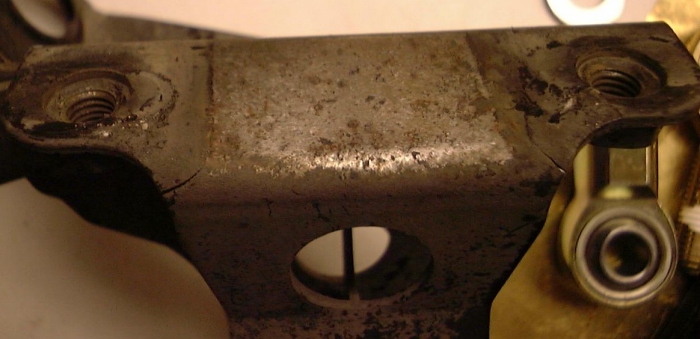
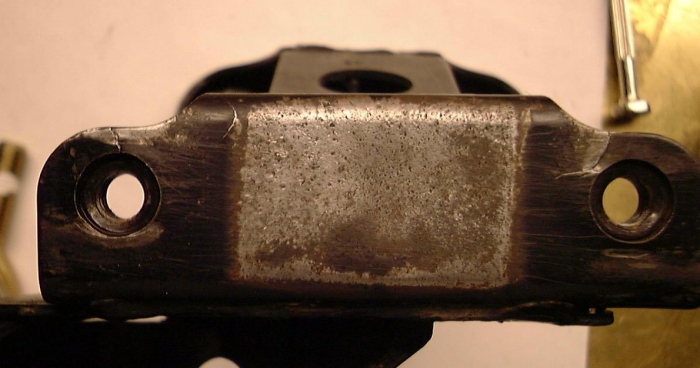

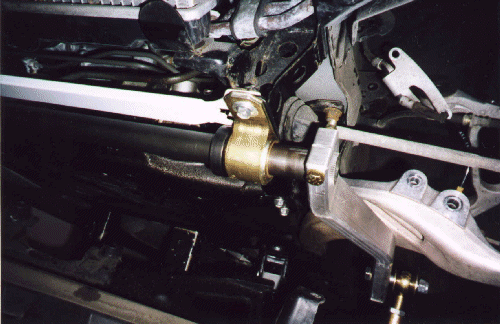
From: "kevin kelleher" (kellehkj@earthlink.net)
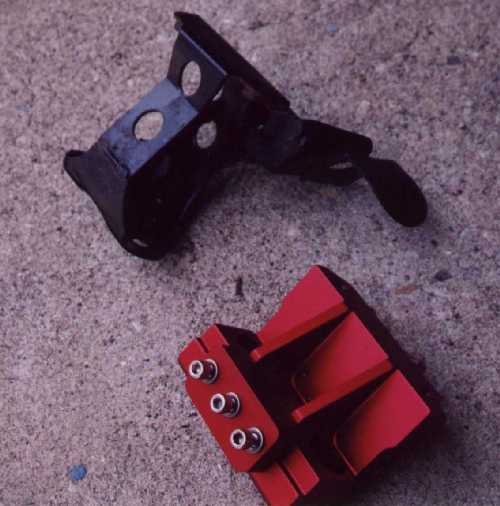
From: David Breslau (breslau@space.mit.edu)
1) It's 1.30" shorter than stock type mounts, so that lowered cars
will not bottom out onto the swaybar clamps, which puts tremendous
loads onto both the mount, and the frame. There is no change in
swaybar function or other interference with the raised bar.
2) It has a *designed in* stabilizing clamp that prevents the side to
side motion that causes fatigue failure of both the OEM mount and
the frame rail. No aftermarket reinforcements are needed, although
the Racing Beat traverse brace works very well with it.
(Editor's note: I took the following photo, which shows the clamp
David is talking about:
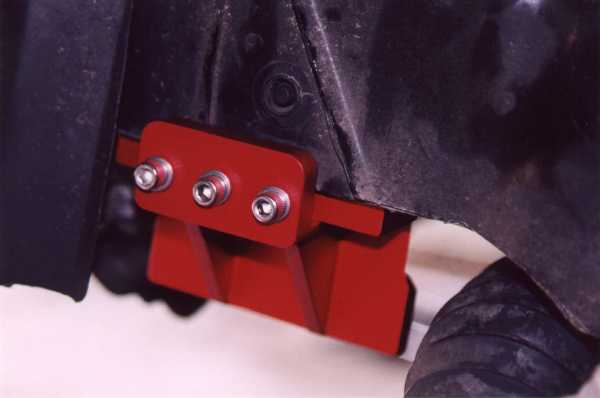
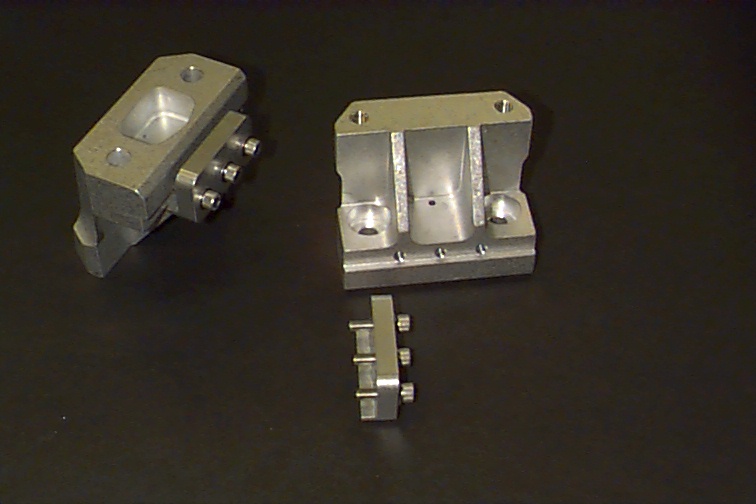
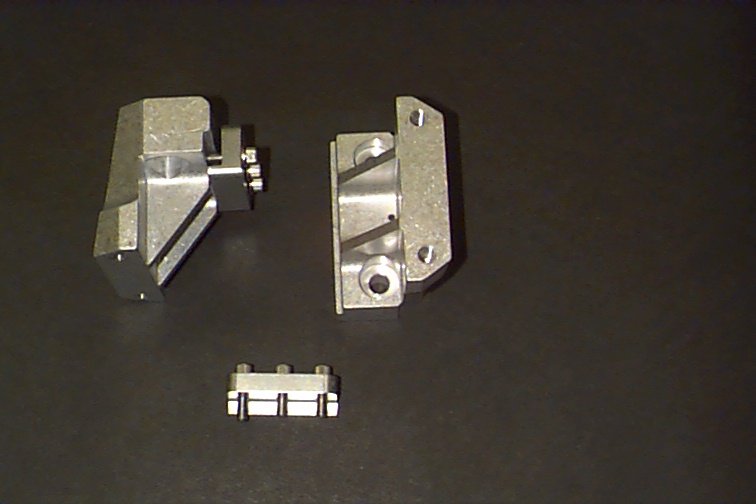
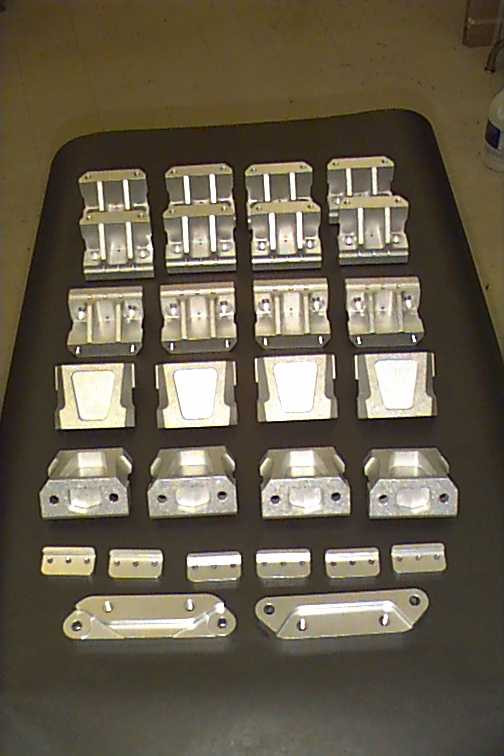
From: "Krumweide, Duane" (dkrumweide@coi-world.com)
Date: December 15, 1999
>I read that the TP braces may have some issues caused by their relocating the bar
>rearward (a problem since the Widefoot raises the bar up by 1.25"?). Can
>anyone shed any new light on this?
Date: May 25, 2000
> Have you gotten any feedback on the spacers for the Tri-Point
> bar?
>One more compatibility note: The Racing Beat lateral brace will not work with
>your mounts since it bolts to the steering rack bolts, and this fixes its
>location at stock height. i.e.- it will require the spacers to be used to get
>the bar back to stock height.
Date: June 14, 2000
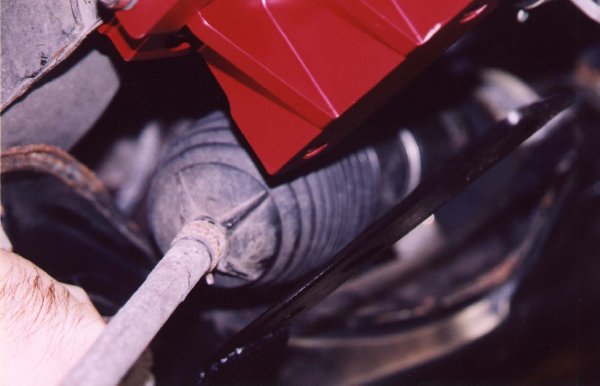
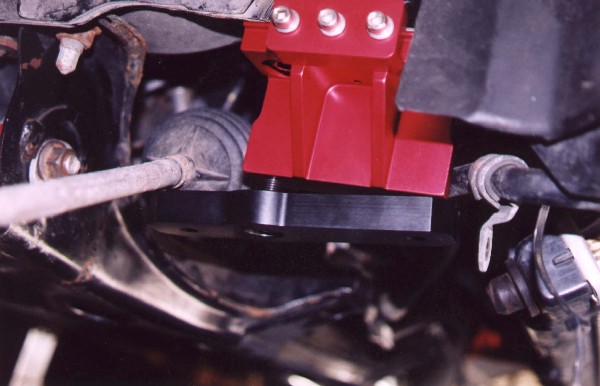
From: "Christopher Regan" (CMR1@nrc.gov)
Subject: (rx7) (3) CWC Widefoot Swaybar Brackets - review
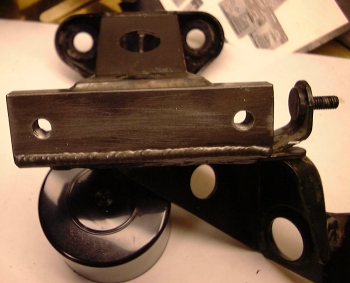
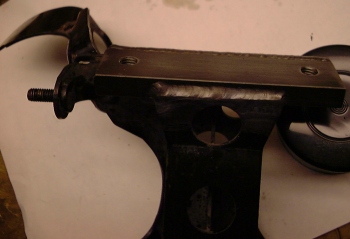
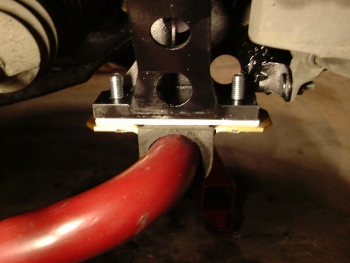
From: "Jim LaBreck (ECA)" (a-jimlab@microsoft.com)
Side view
Bottom view
From: NetBlazer (netb@world.bc.ca)
From: NetBlazer (netb@bisc.com)
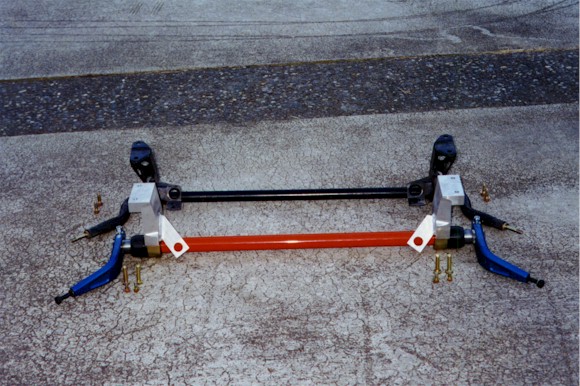
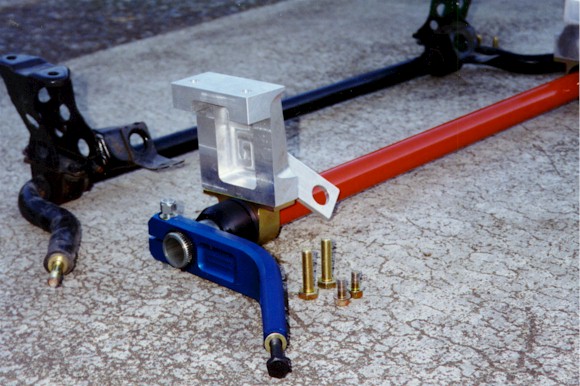

Brace Legality for SCCA Solo II
Date: 09/27/2002 08:58 AM
93 R1
From: Howard Duncan [mailto:Hduncan@scca.com]
Sent: Thursday, September 26, 2002 6:21 PM
To: Sandro LaRosa
Subject: RE: Solo II rules interpretation - Section 13.7
SCCA Director of Program Development
303-779-6622, FAX 303-694-3654
1-800-770-2055
